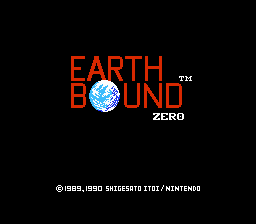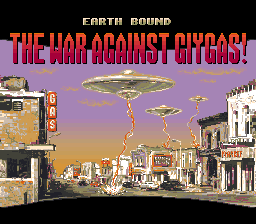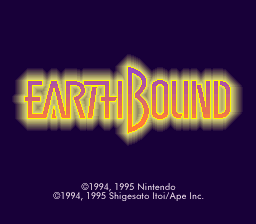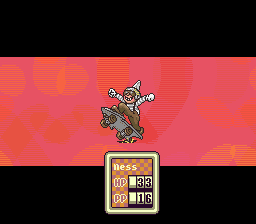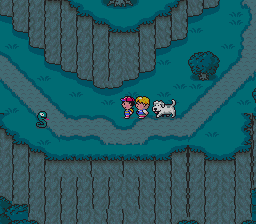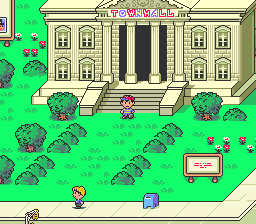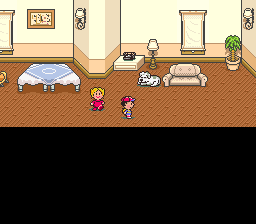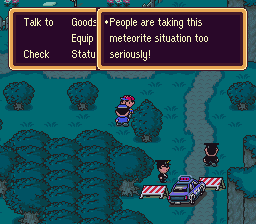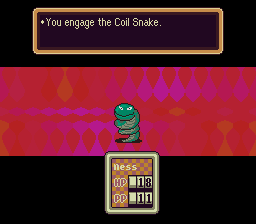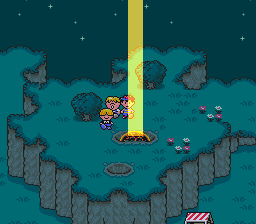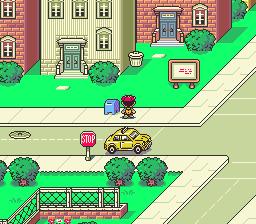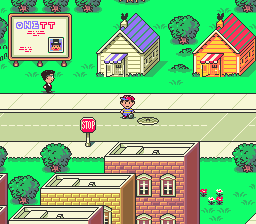Friday, December 24, 2010
Forbidden Siren
Ask any horror game fan what there favourite horror games are and the Silent Hill series is bound to come up. Eschewing the cheap jump scares of other horror games, the Silent Hill series instead goes for psychological horror creating a creepy and often depressing sense of unease through it's visuals and isolation. The series is also reknowned for its storytelling, exploring deep emotional themes in abstract ways. Horror fans were rightfully excited to hear that when Team Silent was disbanded after the third game in the series some former members were working on a new horror game, Forbidden Siren or Siren outside of Europe, for the Playstation 2.
Forbidden Siren is set in the small japanese mountain village of Hanuda over the course of 3 days. After what seems to be an earthquake the town has become surrounded by a sea of blood red water and all the water and rain has been turned to the same blood red colour. Most of the inhabitants have become zombie like creatures called Shibito. Although barely sentient these creatures are capable of wielding weapons, even guns and rifles, and will attack you on sight. If left alone most will go about performing corruptions of their usual daily routines.
The game follows over 10 survivors of this catastrophe that haven't been turned to shibito and follows their attempts to survive. The survivors have found that they have the ability to 'sight jack' any other character or shibito and are able to see through their eyes. This is the major gameplay hook of the series. By holding down R1 and moving the right analogue stick in the direction of any character or shibito will let you see through their eyes. It's essentially like tuning a radio. Sight jacking is a fantastic mechanic that allows you to map out enemy patrol routes so you can avoid them or use it to look for any clues that can't normally see. Shibito have better eyesight than human characters and will let you see further in the dark or fog. It works brilliantly as a device in a horror game since you are totally defenseless while sight jacking, there's nothing more terrifying than sight jacking a shibito only to see the back of your character through its eyes as it shambles towards you for the kill.
The storyline is told in a non-linear fashion with the story jumping between people and events at different points in the timeline. While initially very confusing you will begin to piece the story together about what is happening on the island and about the people that live there to uncover the mystery. It's fantastically told and one of the best pieces of horror writing ever, right up there with the likes of Silent Hill 2 and System Shock 2. Even with so many characters to keep track of all with their own substories it never becomes difficult to follow. The game uses digitally scanned faces of real actors on the characters and even though the game takes a running jump into the uncanny valley at times it does humanise them and helps you sympathise with the characters. You will become emotionally involved and attached to these characters and at times the game is heartbreaking because most characters will not make it to the end. One characters story in particular comes to an end in one of the most harrowing scenes I've witnessed in a videogame.
Each character plays completely differently from each other. Only some characters are armed in the game. Most have melee weapons although a few have access to handguns and one has acess to a rifle. Ammo for these weapons is scarce and has to be used only when necessary to beat stages. Other characters are completely unarmed and must rely on stealth to avoid contact with shibito. Characters vary in their resilience with adolescent characters capable of taking some punishment while one of the children you play as won't survive being hit even once. You will return many times to the same locations in the game but with different characters each stage must be approached in unique ways.
Coming from former members of Team Silent you'd expect the game to hold up very well visually. The setting of Hanuda village is very unsettling, with the small communities in this mountain region now filled with shambling shibito. Most stages take place at night and when not pitch black are covered with a thick nearly inpenetrable fog. It's hard to see more than a few feet ahead of yourself. Some characters have flashlights but using them will only attract shibiot so they should only be used when absolutely necessary. The soundtrack is brilliantly composed and fits the eerie desolate mood of the game.
From the amazing soundtrack, great visuals, fnatastic and innovative sight jacking system and one of the best horror stories ever written we have the makings of one of the best games ever made. However the game is letdown by some very serious flaws. The biggest flaw is that new stages won't open up unless you complete a series of secondary tasks in a level. These might require you to throw a switch or pick up an item but sometimes they are even more elaborate and confusing, bordering on the complicated puzzles of point and click adventures. These are hardly ever sign posted and are difficult to work out and can require a lot of trial and error. Some challenges will require you to find hotspots in areas to interact with the environment that aren't signposted and are only be found after a lot of frustration. These types of puzzles work in point and click adventure games since you take them at your own pace. It's a completely different situation when you have deadly shibito chasing after you. If you don't complete these secondary objectives the game will loop back around and continue making you complete levels you've already finished until you open a new path. The player is never told why the game is looping. It's a crazy design decision. You'll need to be consulting gamefaqs to figure out some of the more obtuse puzzles if you don't want to be frustrated.
The game also requires you to go back and play each level twice with new objectives. Some can require just beating the level in a different way or meeting much harsher conditions or with new objectives. Some of these require you to beat the level in a very strick time limit and which can be really obnoxious. Again some of the new objectives are really obtuse and may require using gamefaqs to save your sanity.
The localisation is really jarring as well. The characters are japanese and setting is in Japan so whoever was in charge of the localisation and gave all the characters voice actors with strong english accents deserves to be shot. This is the perfect game to have japanese voice actors and english subtitles but there's no option. The english voice acting is only passable.
Forbidden Siren is so close to being a horror videogame classic but some really daft design decisions really hold the game back from being counted among the likes of Silent Hill 2 and System Shock 2. It's still a game well worth experiencing, especially for a horror game affecionado due to it's superb plot and sight jacking mechanics. There is a sequel to the game on the PS2 that is said to be a big improvement and a remake for the PS3 called Blood Siren. Supposedly it's a much better game even if many of the characters have been replaced by american characters.
Monday, November 29, 2010
Early thoughts on Final Fantasy 13
I heard lots of bad things about this game. It's incredibly linear. The start of the game is a 20 hour tutorial. The story is rubbish. I also think Square Enix are incapable of making a great RPG anymore.
Well I decided to play it out of morbid curiosity and I've gotten close to the end of chapter 4 (a little bit after getting Odin). I have to say I'm really enjoying it. The battle system is superb, like really good. I usually hate the ATB system and felt it's never worked properly with turn based systems being so much better but I think they nailed it this time and the complete overhaul makes a frantic and yet tactical battle system. The harder fights feel like the boss fights of FF12 which in my opinion was the only time the battle system actually worked in that game. It seems to work for every battle in this game.
The 20 hour tutorial is kind of hyperbole but I admit it did take a while before pressing just X got you through every battle. At the point I'm at the battle system has been excellent since I gained access to the paradigm shifts.
The linearity thing is not a problem for me. People foget that FFX, one of the best FF games was just as linear. Also people don't realise that previous FF games from FF4 onwards, with the exception of FF6 and FF12 were totally linear affairs. They only gave the illusion of freedom but you were always being ferried from point A to B to C. The omission of towns is a little more jarring. Although in FF games they were rarely functional gameplay-wise but they did add a lot to the world and by giving you an insight into how normal people of the world felt.
I'm finding the story interesting enough. The world of Cocoon and Pulse is fascinating, I'm reallty enjoying the setting and the amount of work put into the mythos of this universe. The quite frankly stunning graphics and art really help as well. Characters aren't too bad, Sazh is a real stand out while Vanille at the moment is hateful but she's the only weak one so far in a good cast.
I might change my mind but this is definitely not the disaster it's been made out to be. In fact it'sone of the most enjoyable games of the year for me.
Well I decided to play it out of morbid curiosity and I've gotten close to the end of chapter 4 (a little bit after getting Odin). I have to say I'm really enjoying it. The battle system is superb, like really good. I usually hate the ATB system and felt it's never worked properly with turn based systems being so much better but I think they nailed it this time and the complete overhaul makes a frantic and yet tactical battle system. The harder fights feel like the boss fights of FF12 which in my opinion was the only time the battle system actually worked in that game. It seems to work for every battle in this game.
The 20 hour tutorial is kind of hyperbole but I admit it did take a while before pressing just X got you through every battle. At the point I'm at the battle system has been excellent since I gained access to the paradigm shifts.
The linearity thing is not a problem for me. People foget that FFX, one of the best FF games was just as linear. Also people don't realise that previous FF games from FF4 onwards, with the exception of FF6 and FF12 were totally linear affairs. They only gave the illusion of freedom but you were always being ferried from point A to B to C. The omission of towns is a little more jarring. Although in FF games they were rarely functional gameplay-wise but they did add a lot to the world and by giving you an insight into how normal people of the world felt.
I'm finding the story interesting enough. The world of Cocoon and Pulse is fascinating, I'm reallty enjoying the setting and the amount of work put into the mythos of this universe. The quite frankly stunning graphics and art really help as well. Characters aren't too bad, Sazh is a real stand out while Vanille at the moment is hateful but she's the only weak one so far in a good cast.
I might change my mind but this is definitely not the disaster it's been made out to be. In fact it'sone of the most enjoyable games of the year for me.
Friday, November 12, 2010
Donkey Kong Country and Donkey Kong Country 2
Donkey Kong Country
The tail end of 1994 when Donkey Kong Country (DKC) was first released was a very interesting time for videogames. The 3DO, Atari Jaguar and Amiga CD32 were out and demonstrating 3D home gaming which had once only been the preserve of expensive arcade machines and high end PCs. None of these consoles were successful but two upcoming consoles looked much more promising. The Sega Saturn was released in Japan a few days before DKC and around the corner was a newcomer, the Sony Playstation, that sported games such as the gorgeous but ultimately shallow Battle Arena Toshinden and most importantly a practically arcade perfect conversion of Ridge Racer, then the most popular and best looking game in the arcades. Nintendo’s next console the Ultra 64, later to be released as the Nintendo 64 was deep in development hell and still a long way off.
DKC came along at the perfect time for Nintendo. Instead of the traditional hand drawn 2D sprites that most games used at the time DKC used pre-rendered graphics. Advanced 3D models were created on expensive computer work stations and 2D pictures of these were taken and used as sprites and backgrounds in the game. When combined with some good animation it gave the graphics a pseudo 3D quality that looked far more advanced than anything at the time. The press went crazy over the graphics proclaiming that there was no need to get a new console when the 16-bit machines were making games that looked this good. This was followed by rave reviews at release. DKC went a long to keeping the SNES viable during the start of the 32-bit era and up until when Nintendo finally released the N64 about 2 years later. It was also the game that finally pushed sales of the SNES ahead of the Genesis (the American name for the Megadrive) in the US.
So how does the game hold up after all these years? Well not that well really. Firstly those then state of the art graphics don’t look great anymore. It’s fairly obvious now that everything is made up of 2D pictures of 3D pre-renders. Everything looks like it’s made of incredibly shiny plastic and the sprites are grainy which shows up a lot worse on modern TVs. It’s not all bad, the game makes great use of the SNES’s capabilities with some nice mode 7 effects used to give depth to the backgrounds and some of the stages set in the dark are technically impressive. It all looks very garish and just not appealing like most of the other 16-bit games that used the same pre-rendered technique. This technique was actually better suited to the capabilities of the32-bit machines with games like FFVII and Resident Evil using the same technique and looking an awful lot better than their 16-bit counterparts which looked a lot more pixelated due to the compression needed to fit them on the cartridges and the smaller colour palettes of these consoles. It doesn’t help that I’m not a fan of Rare’s overly cute art style that so desperately wants to mimic Nintendo and fails.
Behind the graphics the game is pretty much your vanilla 2D platformer that where two a penny back then and doesn’t do much to stand out from the crowd. The game has a two character system where you control either Donkey Kong, the stronger of the two, or Diddy Kong, weaker but more agile. However the differences between the two characters aren’t all that pronounced and it ends up just working as a system where having both characters affords you an extra hit without losing a life. The biggest issue with DKC is that the level design just doesn’t stand out. There’s only a small handful of backgrounds that get repeated and a lot of the level design isn’t memorable compared to say Super Mario World were each level is unique and adds something new to the platforming formula. That’s not to say it’s totally lacking in variety, the dark levels are well designed, the mine carts are a fun diversion and the underwater levels help break the action up, but too many of the levels are throw away designs. Later levels can become difficult rather than challenging and frustrating as a result. These final few stages are more a chore than anything.
I’m probably sounding overly negative about the game but it’s really not a bad game just not deserving of the unbridled praise it received on release. It’s still a fun diversion. However as a good 2D platformer on the SNES which was swimming in quality 2D platformers it doesn’t come close to the systems best. I’ll tell you what though, the soundtrack was amazing!
Donkey Kong Country 2: Diddy’s Kong Quest
DKC2 was released almost a year after the first game. It used the same pre-rendered graphical style of the first game but instead of a jungle theme it was replaced with a pirate theme. The gameplay remains largely the same with the biggest change being Donkey Kong has been replaced by a new female character Dixie Kong, since Donkey Kong’s been captured as part of the story. Unlike the first game Diddy Kong and Dixie Kong play a quite differently to each other than the duo in DKC. Diddy Kong is again more agile, can jump higher and can throw barrels faster while Dixie Kong can extend her jump using her ponytail as a makeshift helicopter blade.
DKC2 addresses a lot of the flaws I had with the first game although it’s still not without its issues. Most importantly there is much more variety between levels than in the first game. Sure there are some throw away forgettable levels that seem to be rehashes of previous ones but overall it’s a massive improvement on the first game. Level design all round has been improved. Levels are designed so that you can speed run them. There’s new collectibles added that cater for the OCD completionist who wants to get 100%, or in the case of this game 102% due to a bug. These are fiendishly hidden and collecting them opens up new levels and a secret boss if you collect them all. Graphically the pre-rendered look is just as ugly as the first game but there are a few stages that do stand out. The underwater levels look gorgeous and some fancy mode 7 work creates some very convincing fake 3D backgrounds in some levels. In another level light filters in through the trees and looks rather impressive. DKC2 is much tougher than the first game and some later levels can again become very frustrating to play through, especially any of the bramble levels which can be maddening and spoils the end game a bit. Again the soundtrack is another standout.
DKC2 is a big improvement on the first game but I feel it’s still lacking compared to the Super Nintendo’s best games. It’s let down by some of its later levels being a lesson in frustration. The new collectible and speed run nature of the level design do give the game a lot more replayability. It’s worth a play for nostalgia purposes but there are much better platformers out there that are more deserving of your time.
Monday, October 11, 2010
Donkey Kong Jr. Game and Watch Mini
I recently came into possession of one of these Game & Watch mini keychains (thanks Sarah!). My only experience of Game & Watches was looking longingly at the Game & Watch machines the luckier kids owned and who were too mean to give me a go of so it's nice to finally play one. Even better, supposedly Donkey Kong Jr. is one of the best G&W machines.
I’m actually surprised with how well DK Jr. holds up considering the hardware is more primitive than the Gameboy; the original supposedly came out in 1982. It’s real gameplay over graphics stuff. The aim of the game is to release Donkey Kong who has been captured by Mario (yes that Mario, he’s the bad guy in the Donkey Kong Jr. games). First you have to reach him by avoiding snappers by jumping over them or using the vines to evade them while watching out for birds. Once you get to the cage you have to time your jump to catch the swinging key to release Donkey Kong.
DK Jr. is a really fast paced score attack game and perfect for the portable format it’s on. You get a better score depending on how fast you reach Donkey Kong and there’s also a coconut you can drop on enemies to increase your score. The sound isn’t anything more advanced than beeps but impressively it varies rhythmically with how quick the enemies are coming for you, adding some tension as the pace of the game increases. You can mute the noise if you want if you don’t want to drive anyone nearby insane. The only problem I see is that the score is limited to 999 and when it exceeds this it is reset but this was a problem with the original hardware so it’s authentic. The clock and alarm functions of the original are also present.
It’s a fantastic little gadget and well worth owning. The gameplay has really stood the test of time and is a nice little nostalgia trip if you are one of the pricks that was playing Mario Bros. cake factory and wouldn’t give me a go. I’m not bitter.
Friday, September 10, 2010
Y's Seven: Premium Edition
This just arrived in the post for me today. I usually never get special editions of games since they are just bundled with overpriced useless tat but in this case I feel it was worth it. I’ve heard people say that the PSP has become the Sega Saturn of this generation, a console that is effectively dead in the West but kept alive by hardcore gamers in Japan. It says a lot about a system when the excellent Metal Gear Solid: Peace Walker can’t sell well on it. However it does mean that there have been a lot of excellent niche Japanese titles making their way on to the format, such as the Persona remake and the recently released Valkyria Chronicles 2.
Small publisher XSeed recently signed a deal with Falcom to publish in the US three games in the Y’s series (Ys Seven, Ys: The Oath in Felghana, and Ys I & II Chronicles) and three titles from the Legend of Heroes series. I hope this works out for XSeed but it does seem like financial suicide. Bringing out six very niche games to a system that is dead in the US is very brave but admirable since otherwise these games would never have received an English language translation. I thought splashing out on the Premium Edition in this case was worth it because, you know, every little helps and I hope it works out for them.
Anyway here’s what you get in the Premium Edition:
So if you have any interest in owning one of the best RPGs of the year I suggest you import the Premium Edtion. It’s only a fiver more expensive than the standard edition and about the same price as what you would pay for a PSP game in the shops here.
Small publisher XSeed recently signed a deal with Falcom to publish in the US three games in the Y’s series (Ys Seven, Ys: The Oath in Felghana, and Ys I & II Chronicles) and three titles from the Legend of Heroes series. I hope this works out for XSeed but it does seem like financial suicide. Bringing out six very niche games to a system that is dead in the US is very brave but admirable since otherwise these games would never have received an English language translation. I thought splashing out on the Premium Edition in this case was worth it because, you know, every little helps and I hope it works out for them.
Anyway here’s what you get in the Premium Edition:
- Y’s Seven game
- Oversized cloth map of the world that Y’s is set in
- 60 page Y’s artbook
- And most important of all, Y’s Seven music selection.
So if you have any interest in owning one of the best RPGs of the year I suggest you import the Premium Edtion. It’s only a fiver more expensive than the standard edition and about the same price as what you would pay for a PSP game in the shops here.
Thursday, September 9, 2010
Thief: The Dark Project
Despite being critically acclaimed by the press and being told countless times by friends that I should play it I only got around to finishing Thief recently. After being blown away by the quite frankly amazing System Shock 2 I realised that it was high time that I should try this game out considering it was developed in tandem by many of the same team. Luckily I was able to pick up the Thief Complete Collection and I suggest anyone else interested in trying this game out should pick up this collection since it includes Thief Gold (a re-release of The Dark Project but with extra levels and tweaks), Thief 2: The Metal Age and Thief Deadly Shadows. So 3 critically acclaimed games for a very reasonable price, not bad.
First thing you’ll notice about Thief is that the game probably won’t run at all if you are using Vista or Windows 7, possibly even XP. If you are having trouble getting Thief 1 and 2 running I suggest you follow the guides on these sites which helped me out:
http://forums.eidosgames.com/showthread.php?t=76531
http://www.johnanthonycurran.com/thief.html
Thief has a strange but interesting hybrid medieval setting with slight steampunk and fantasy elements. The main political faction is the Order of the Hammer, or Hammerites, that worship technology and architecture. The Hammerites are at odds with another religious sect, the Pagans, whose nature worshipping beliefs clash with the beliefs of the Hammerites. There is another faction in the world called the Keepers that are secretive and rarely seen or heard of that clandestinely manipulate events from the shadows to prevent any outbreaks of chaos. You play as Garrett, a former member of the keepers that became disillusioned with their ways and left. He uses his skills at subterfuge that he learn with the keepers to become a master thief in the metropolis only known as the City. His only motivation is entirely selfish; to steal so that someday he can earn enough money to live a comfortable life.
Thief is played out in a first person perspective but despite sharing this perspective with the dumb first person perspective shooters of today like Call of Duty and Halo, Thief is a totally different game. While these games have you as a nigh on invincible soldier running and gunning down enemies as Garrett must rely on stealth to survive. In Thief the darkness is your best friend. Hiding in the shadows makes you completely invisible to enemies so that you don’t alert them. Garrett may have a sword to but he isn’t a great swordsman and it should only be used as a last line of defence. He can use a bow and arrow but he has a limited number of these, they take a long time to draw back and ready and are also difficult to aim since you have to compensate for the drop due to gravity. However killing enemies is not an efficient way to play the game. It’s noisy and leaves blood stains that can alert guards who are a lot harder to take down in an alerted state. The proper way to go about your thievery is to catch the guards unawares and hit them over the head with your trusty ‘blackjack’ club to knock them unconscious and then hide the body from any patrolling guards.
This unique stealth gameplay is what sets Thief apart and there really is no other game like it other than its immediate sequels. There are other areas that Thief really stands out in. Level design in this game is some of the best I’ve ever encountered in the game. Each mission is a sprawling non-linear affair that can take upwards of 90 minutes to complete. The range of environments is very diverse, from sneaking through massive mansions avoiding patrols and finding secret passageways, lost cities buried for year’s underground, swimming through mines to break into a prison or an old haunted church. Each level has numerous hidden passages and secrets often leading to small snippets of information that can help you piece together the complex story or adds context to the Thief universe. Missions usually task you with not only stealing certain objects but also with escaping alive so you better have an escape plan.
Garrett isn’t totally defenceless. Along with his sword and arrows he also has a wide variety of speciality equipment he can use to his advantage. Water arrows can be used to douse flames thus creating even more dark areas to hide in. Fire arrows can be used to light fires and cause massive damage to the more dangerous foes. Moss arrows can cover the ground in moss letting Garrett walk over even the noisiest surfaces without making a sound. And Rope arrows can be fired into soft surfaces leaving a rope that gives greater mobility. There’s plenty of other gadgets, such as noisemaker arrows, flashbombs, mines, etc. that can be used in creative ways to terrorise the guards.
One of most novel aspects of the game is how difficulty levels are handled. Instead of increasing the number of enemies or how much punishment they can take, Thief just adds new objectives. While normal will require you to steal an object and exit the area alive the same level on hard will require you to steal additional items in hard to reach places and leave with a large value of additional loot without killing any unarmed innocents. People playing on Expert are usually required to carry out these tasks without killing anyone.
Sound also plays a massive role in gameplay and level design and is some of the best use of sound design I’ve seen in a game. Hints about the mission you are on can be gathered from overheard conversations. You also have to watch how much noise you make yourself since it can alert guards and can make your life a whole lot more difficult, you’ll be constantly watching what you thread on. Grass and carpet will allow you to move effortlessly without a sound but you will feel dread when you come across a room you have to cross with a floor of noisy ceramic tiles or metal grating requiring you to slowly inch your way to your destination. Another level requires you to steal an artefact that produces music and you must use this to get your bearings by judging how close you are by how loud the music is and where it’s coming from.
Thief really is one of the best games ever made but it can be hard to get into in this day and age. For one thing the graphics really have dated badly. The ‘Dark Engine’ was revolutionary in its day, especially its shadow effects and AI, but is very much of its time. The models are all very low polygon and look very ugly. The environments come off a lot better despite looking very basic by today’s standards. They are quite detailed and have good art design helping them stand out and making each mission look realistic and lived in. It can take a while to get used to the unique pace of the game. Most people are used to modern FPS games but Thief is the polar opposite, requiring you to really take your time and be patient since it’s a much slower paced game. It’s also a very tough game so you’ll need to use that auto save button a lot. However there really is nothing else like it and it’s a game well worth experiencing if you can look past some dated visuals. The story is also very interesting, seeming like a few random robbery jobs but eventually coming together at the halfway point and getting a whole lot more interesting. If there’s one complaint I have to make it’s that in one or two levels the hard and expert objectives are too well hidden with no clues as to where they are kept and required a walkthrough to find but other than that it’s well worth experiencing this unique and brilliant game.
First thing you’ll notice about Thief is that the game probably won’t run at all if you are using Vista or Windows 7, possibly even XP. If you are having trouble getting Thief 1 and 2 running I suggest you follow the guides on these sites which helped me out:
http://forums.eidosgames.com/showthread.php?t=76531
http://www.johnanthonycurran.com/thief.html
Thief has a strange but interesting hybrid medieval setting with slight steampunk and fantasy elements. The main political faction is the Order of the Hammer, or Hammerites, that worship technology and architecture. The Hammerites are at odds with another religious sect, the Pagans, whose nature worshipping beliefs clash with the beliefs of the Hammerites. There is another faction in the world called the Keepers that are secretive and rarely seen or heard of that clandestinely manipulate events from the shadows to prevent any outbreaks of chaos. You play as Garrett, a former member of the keepers that became disillusioned with their ways and left. He uses his skills at subterfuge that he learn with the keepers to become a master thief in the metropolis only known as the City. His only motivation is entirely selfish; to steal so that someday he can earn enough money to live a comfortable life.
Thief is played out in a first person perspective but despite sharing this perspective with the dumb first person perspective shooters of today like Call of Duty and Halo, Thief is a totally different game. While these games have you as a nigh on invincible soldier running and gunning down enemies as Garrett must rely on stealth to survive. In Thief the darkness is your best friend. Hiding in the shadows makes you completely invisible to enemies so that you don’t alert them. Garrett may have a sword to but he isn’t a great swordsman and it should only be used as a last line of defence. He can use a bow and arrow but he has a limited number of these, they take a long time to draw back and ready and are also difficult to aim since you have to compensate for the drop due to gravity. However killing enemies is not an efficient way to play the game. It’s noisy and leaves blood stains that can alert guards who are a lot harder to take down in an alerted state. The proper way to go about your thievery is to catch the guards unawares and hit them over the head with your trusty ‘blackjack’ club to knock them unconscious and then hide the body from any patrolling guards.
This unique stealth gameplay is what sets Thief apart and there really is no other game like it other than its immediate sequels. There are other areas that Thief really stands out in. Level design in this game is some of the best I’ve ever encountered in the game. Each mission is a sprawling non-linear affair that can take upwards of 90 minutes to complete. The range of environments is very diverse, from sneaking through massive mansions avoiding patrols and finding secret passageways, lost cities buried for year’s underground, swimming through mines to break into a prison or an old haunted church. Each level has numerous hidden passages and secrets often leading to small snippets of information that can help you piece together the complex story or adds context to the Thief universe. Missions usually task you with not only stealing certain objects but also with escaping alive so you better have an escape plan.
Garrett isn’t totally defenceless. Along with his sword and arrows he also has a wide variety of speciality equipment he can use to his advantage. Water arrows can be used to douse flames thus creating even more dark areas to hide in. Fire arrows can be used to light fires and cause massive damage to the more dangerous foes. Moss arrows can cover the ground in moss letting Garrett walk over even the noisiest surfaces without making a sound. And Rope arrows can be fired into soft surfaces leaving a rope that gives greater mobility. There’s plenty of other gadgets, such as noisemaker arrows, flashbombs, mines, etc. that can be used in creative ways to terrorise the guards.
One of most novel aspects of the game is how difficulty levels are handled. Instead of increasing the number of enemies or how much punishment they can take, Thief just adds new objectives. While normal will require you to steal an object and exit the area alive the same level on hard will require you to steal additional items in hard to reach places and leave with a large value of additional loot without killing any unarmed innocents. People playing on Expert are usually required to carry out these tasks without killing anyone.
Sound also plays a massive role in gameplay and level design and is some of the best use of sound design I’ve seen in a game. Hints about the mission you are on can be gathered from overheard conversations. You also have to watch how much noise you make yourself since it can alert guards and can make your life a whole lot more difficult, you’ll be constantly watching what you thread on. Grass and carpet will allow you to move effortlessly without a sound but you will feel dread when you come across a room you have to cross with a floor of noisy ceramic tiles or metal grating requiring you to slowly inch your way to your destination. Another level requires you to steal an artefact that produces music and you must use this to get your bearings by judging how close you are by how loud the music is and where it’s coming from.
Thief really is one of the best games ever made but it can be hard to get into in this day and age. For one thing the graphics really have dated badly. The ‘Dark Engine’ was revolutionary in its day, especially its shadow effects and AI, but is very much of its time. The models are all very low polygon and look very ugly. The environments come off a lot better despite looking very basic by today’s standards. They are quite detailed and have good art design helping them stand out and making each mission look realistic and lived in. It can take a while to get used to the unique pace of the game. Most people are used to modern FPS games but Thief is the polar opposite, requiring you to really take your time and be patient since it’s a much slower paced game. It’s also a very tough game so you’ll need to use that auto save button a lot. However there really is nothing else like it and it’s a game well worth experiencing if you can look past some dated visuals. The story is also very interesting, seeming like a few random robbery jobs but eventually coming together at the halfway point and getting a whole lot more interesting. If there’s one complaint I have to make it’s that in one or two levels the hard and expert objectives are too well hidden with no clues as to where they are kept and required a walkthrough to find but other than that it’s well worth experiencing this unique and brilliant game.
Friday, August 27, 2010
The Earthbound/Mother Retrospective
The Mother series
The mother series started as a project by Shigesato Itoi who became fascinated with videogames during the 80's Famicom craze in japan. Itoi was an acclaimed writer and tv personality in japan. He was amazed at the interaction videogames offered but wasn't impressed with the story telling. He decided to approach Nintendo about making a videogame for them. Nintendo jumped at the chance to have such a high profile writer working on a game and the implications it would have. What came of this was the Mother/Earthbound series, one of the most highly acclaimed game series ever that unfortunately isn't very well known in the west.
Mother / Earthbound Zero
Mother was Itoi's first game and was a collaboration between him and HAL laboratories. Although a US release of the game was planned Nintendo dropped it at the last minute. Fortunately a fully translated complete prototype of the game was uncovered and released through rom sites so non japanese speakers can experience it. Considering the rom is dated 1990 the translation is absolutely superb and head and shoulders above the nonsense that passed as a translation in those days or even 7 years later when awful translations like Final Fantasy VII's was considered acceptable. There is the usual nintendo censorship, things like crosses on the churches, cigarettes and some gore from the zombies removed, but over all the game is pretty much the same as the japanese version other than the addition of a run button.
Mother plays very much like the Dragon Quest series. You can choose between physical attacks or psychic 'Psi' atttacks that work like magic. It's very old school. You will need to do a lot of grinding in this game to get anywhere, even for the first area. However the battle system is rather good and there's a lot of strategy involved in the game. If there is a major issue it's that the difficulty of the final stages is ridiculous. You will need to do some ridiculous grinding to get through the final area and in the final section the normal enemies are way harder than even the final boss who can be taken on at much lower levels. Your best bet here is to run away from every battle. Also dungeons are complicated mazes so you are best to get maps and a faq to get through the game.
What sets mother and the whole series apart is the setting. Unlike the usual tolkien rip off or generic sci-fi we see in every RPG the mother series is set in a contemporary 90's setting, a rural 90's middle america in this case, albeit an exagerated japanese prespective of it which makes the game very unique. There's a 1950's sci-fi vibe underlying the plot as well. You don't buy swords or arrows but equip sports equipment like baseball bats and yo-yos to do battle. Even getting your health back requires you to eat regular foods instead of 'potions'. You don't kill enemies, they 'come to their senses'. You encounter a strange assortment of enemies, notable examples being getting attacked by your possessed lamp and new age hippies.
Plotwise you can expect something special with Itoi involved. The game starts with this weird message:
But it's not until the very end that you understand the significance of what is written here. The world of Mother is rather zany. You'll rescue a girl from zombie mafiosa, take on 1950's alien starmen and one sequence see's you driving a tank across a desert, destroying a massive robot before crashing into a cave filled with talking monkeys. The whole game revolves around learning the notes of a lullaby from such objects as a singing cactus, monkey, doll etc. It all seems weird and offbeat without any interconnection but the truth is that storywise the game is a serious work of art. The game really gives you a sense of nostalgia for the silly adventures you got up to as a kid and in this it really does succeed. There's a strange area in the game called Magicant that you will revisit a lot and once you uncover the truth about this area right at the end of the game you are greeted with what is really a very emotional scene that very nearly works and is only kept back by the lack of rom space to add enough exposition. It's amazing that a game can generate so much emotion on an 8-bit platform.
The game is technically outstanding for a NES game. It looks beautiful and the world map is massive, it's probably the biggest game area in a NES game. The biggest stand out is the music which really is some of the best written on NES. A vocal album was released that is incredibly rare to find but is well worth looking up on youtube:
The game is hard to recommend since its archaic ways are very difficult for most modern gamers to get over but as a culturally significant game to someone interested in the medium it really is worth experiencing as long as you know what you are getting in for. I'll leave this section with some screenshots from the beginning of the game.
Unlike Mother, Mother 2 did get a western release under the name of Earthbound. Mother 2 was one of the most highly anticipated games for the SNES in japan and nintendo tried to kickstart an RPG craze in the US with Earthbound. There was a massive advertising campaign and the game was released in a massive box that included a walkthrough guide and scratch and sniff stickers. It sold well but not as well as nintendo had hoped. However the game reached enough gamers to start a cult following for the series in the west, but more on that at the end of the article.
Development of Earthbound started soon after the first game and soon turned into a nightmare development that took over 5 years (most games at the time had turn around times of less than a year). HAL laboratories and APE Inc. were both involved in the development of the game and this caused a lot of the trouble. Co-ordinating two separate teams spearated by a huge distance before the internet really took off was a major hurdle. The games cartridge size had to be increased multiple times to fit the game, starting out at 8-mbit and ending up at a massive for the time 24-mbit. The game did eventually come out and what we ended up with was one of the best RPG games ever made that is just as good today as it's ever been.
Gameplay is much improved over the previous game. It's much better balanced than Mother with no need for endless level grinding. The biggest addition to the game is the rolling health bar. If you take damage your health doesn't immediately decrease but drops slowly. If you can finish the battle or heal quick enough you can stop your health decreasing. Some enemies have attacks that take all your energy outright in one hit but taking them out quickly or healing before your health reaches zero will stop your health decreasing. This simple addition adds a lot of strategy and trepidition to a slow turn based battle system. Another big addition is that there are no longer random battles. All enemies are visible on screen and you can gain the upper hand by attacking them in the back, although they can take advantage of this as well. When you get to a high enough level you can instantly kill the enemies by touching them making backtracking a painless experience. I also love the psychadelic backgrounds that use the SNES mode 7 tricks to their fullest.
Earthbound returns to the modern contemporary world of mother but this time with influence from both America and Europe but with that zany japanese perspective again. Equipment is standard sports paraphenalia and healing items are food stuffs you will find in any food store. You can even use phones to order yourself a pizza that will get delivered to you. You need to use an ATM card to withdraw money. The attention to detail in this area is really what makes this game series totally unique in a sea of generic RPGs. The enemies you meet are crazy and include mushrooms that infect you with a mushroom on your head that if not removed reverses your controls, crazy bag ladies and unwashed homeless bums.
Itoi outdoes himself in the story telling department. There's no need to have played the first game either to enjoy the story. The game starts out with a meteor landing near the main characters house. When he sets out to investigate it he finds a fly living in it that can talk and tells him that he is from the future were everything is destroyed and he is the choosen one to save the world. That is until he gets mistaken for a normal fly and swathed leaving you without a guide. It all seems very generic but it turns into anything but. Some of the scenarios include rescuing a town from a haunted circus filled with zombies, taking down a cult that is obsessed with anything blue and making your way through a desert after getting stuck in a traffic jam. The game is full of memorable scenarios such as the famous mister saturns and your visit to the surreal Fourside which I won't spoil! Nintendo have to be commended on an absolutely stellar translation job that I can't find any fault in.
Itoi's input into the writing of the game is evident from how far ahead the narrative is even compared to games of today. Unlike the first game there's plenty of laugh out loud moments. The game actively takes ridicules many of the RPG conventions. A character in the game will keep coming up with ridiculous machines like the 'Gourmet Yogurt Machine' that seem to have no use but seconds later a character will say they need it, playing on the fact that you always seem to have a tool available to overcome even the silliest of challenges and crises in RPGs. There's even a man that you meet throughout your adventures that builds dungeons as a job. They start out a bit plain but get more intricate as he improves. Again there's real emotional heart to the game with nostalgia being a big theme. The game seems very jolly and light hearted but it all rings false at the end and the game features one of the most nightmarish and disturbing end sections of any game I've experienced. Again I don't want to spoil it but it's absolute genius and uses sound in the same way as the film 'Irreversible' to really upset the player. Itoi envisioned it as the end of innocence during childhood and it succeeds brilliantly. It lulls the player into a false sense of playfulness and catharsis before it's shocking and moving finale shatters these preconceptions.
Earthbound got a lot of stick from the press at the time for being a simple looking game. At the time Donkey Kong Country was the way people thought videogame graphics were going. However time has shown that Earthbound really was a gorgeous looking game while prerendered digitised graphics now look garish and ugly. The game had a really appealing and colourful mix of charlie brown and matt groening that is well detailed and pretty much timeless. It's a fabulous looking game. Music is also of a high standard although I prefer the melodies in the first game.
Earthbound is a game that I'd recommend every RPG fan to play. There really is nothing like it and for a game released in 1994 it's way ahead of it's time with a fantastic battle system and no random battles. However it's Itoi's narrative that really stands out. A true timeless classic that deserves the love and adoration it received. Now for some screenies:
Earthbounds Impact and its Community
The Mother series has built up a big cult following in the West. Earthbound seems to have a strange effect on people. Most people liked the game but there was also a lot of people that fell madly in love with it and everything about it. True earthbound/mother fans are totally obsessed with the franchise. The explosion of internet popularity at the time of the games release has lead to the fanbase to gather around a website that has become the go to source for westerners for all things Mother or Earthbound. That website is Starmen: http://starmen.net/
Earthbounds fanbase are like no other. There's a true community spirit between them all. There's none of the inane bickering that you get in other fanbases or gamers trying to show off how good they are in competitive games, digital dick waving if you will. Everyone just seems to get along which for anyone into gaming culture knows is quite remarkable. When Mother 3 wasn't getting released outside of japan two translation teams began working on translating the game. Usually this would end up in bickering between them both about who started it first and who would get it finished first. However in this case both teams decided to work together to get the project finished quicker, totally unheard of in fan videogame translation circles.
Make no mistake Earthbound fans are probably the craziest videogame fans out there but they kind of know they are and embrace it. Starmen.net has launched it's own line of clothing based on the mother series and brought out a complete glossy strategy guide for mother 3 when the unofficial english translation was completed. It really goes to show the amount of love the fans have for the series.
Unfortunately I haven't played Mother 3 so can't cover it which is a shame since it's even more interesting than the first two games. It had been in development starting as a game for the ill fated N64 DD add-on before becoming an N64 title. It was completed but scrapped by Itoi because he didn't like the art style due to the primitive 3D of the N64. The game eventually resurfaced years later on the Gameboy Advance. Itoi kept the same story as the N64 game. The GBA was popular enough at the time for the game to find it's audience but more importantly to Itoi could also provide the gorgeous 2D visuals he preferred to the N64's low polygon models and enviroments and kept the look and feel similar to previous games. The game was released at the end of the GBA's life and would have taken nintendo too long to translate so it never saw a release in the west but an unofficial translation by fans was eventually released on the internet after 2 years of hard work. I've heard the game is very emotional, dealing with the loss of loved ones and the unstoppable changing of the environment we grow up in and is supposedly one of the best games ever made. I hope I manage to get around to it soon.
The mother series started as a project by Shigesato Itoi who became fascinated with videogames during the 80's Famicom craze in japan. Itoi was an acclaimed writer and tv personality in japan. He was amazed at the interaction videogames offered but wasn't impressed with the story telling. He decided to approach Nintendo about making a videogame for them. Nintendo jumped at the chance to have such a high profile writer working on a game and the implications it would have. What came of this was the Mother/Earthbound series, one of the most highly acclaimed game series ever that unfortunately isn't very well known in the west.
Mother / Earthbound Zero
Mother was Itoi's first game and was a collaboration between him and HAL laboratories. Although a US release of the game was planned Nintendo dropped it at the last minute. Fortunately a fully translated complete prototype of the game was uncovered and released through rom sites so non japanese speakers can experience it. Considering the rom is dated 1990 the translation is absolutely superb and head and shoulders above the nonsense that passed as a translation in those days or even 7 years later when awful translations like Final Fantasy VII's was considered acceptable. There is the usual nintendo censorship, things like crosses on the churches, cigarettes and some gore from the zombies removed, but over all the game is pretty much the same as the japanese version other than the addition of a run button.
Mother plays very much like the Dragon Quest series. You can choose between physical attacks or psychic 'Psi' atttacks that work like magic. It's very old school. You will need to do a lot of grinding in this game to get anywhere, even for the first area. However the battle system is rather good and there's a lot of strategy involved in the game. If there is a major issue it's that the difficulty of the final stages is ridiculous. You will need to do some ridiculous grinding to get through the final area and in the final section the normal enemies are way harder than even the final boss who can be taken on at much lower levels. Your best bet here is to run away from every battle. Also dungeons are complicated mazes so you are best to get maps and a faq to get through the game.
What sets mother and the whole series apart is the setting. Unlike the usual tolkien rip off or generic sci-fi we see in every RPG the mother series is set in a contemporary 90's setting, a rural 90's middle america in this case, albeit an exagerated japanese prespective of it which makes the game very unique. There's a 1950's sci-fi vibe underlying the plot as well. You don't buy swords or arrows but equip sports equipment like baseball bats and yo-yos to do battle. Even getting your health back requires you to eat regular foods instead of 'potions'. You don't kill enemies, they 'come to their senses'. You encounter a strange assortment of enemies, notable examples being getting attacked by your possessed lamp and new age hippies.
Plotwise you can expect something special with Itoi involved. The game starts with this weird message:
But it's not until the very end that you understand the significance of what is written here. The world of Mother is rather zany. You'll rescue a girl from zombie mafiosa, take on 1950's alien starmen and one sequence see's you driving a tank across a desert, destroying a massive robot before crashing into a cave filled with talking monkeys. The whole game revolves around learning the notes of a lullaby from such objects as a singing cactus, monkey, doll etc. It all seems weird and offbeat without any interconnection but the truth is that storywise the game is a serious work of art. The game really gives you a sense of nostalgia for the silly adventures you got up to as a kid and in this it really does succeed. There's a strange area in the game called Magicant that you will revisit a lot and once you uncover the truth about this area right at the end of the game you are greeted with what is really a very emotional scene that very nearly works and is only kept back by the lack of rom space to add enough exposition. It's amazing that a game can generate so much emotion on an 8-bit platform.
The game is technically outstanding for a NES game. It looks beautiful and the world map is massive, it's probably the biggest game area in a NES game. The biggest stand out is the music which really is some of the best written on NES. A vocal album was released that is incredibly rare to find but is well worth looking up on youtube:
The game is hard to recommend since its archaic ways are very difficult for most modern gamers to get over but as a culturally significant game to someone interested in the medium it really is worth experiencing as long as you know what you are getting in for. I'll leave this section with some screenshots from the beginning of the game.
Mother 2 / Earthbound
Unlike Mother, Mother 2 did get a western release under the name of Earthbound. Mother 2 was one of the most highly anticipated games for the SNES in japan and nintendo tried to kickstart an RPG craze in the US with Earthbound. There was a massive advertising campaign and the game was released in a massive box that included a walkthrough guide and scratch and sniff stickers. It sold well but not as well as nintendo had hoped. However the game reached enough gamers to start a cult following for the series in the west, but more on that at the end of the article.
Development of Earthbound started soon after the first game and soon turned into a nightmare development that took over 5 years (most games at the time had turn around times of less than a year). HAL laboratories and APE Inc. were both involved in the development of the game and this caused a lot of the trouble. Co-ordinating two separate teams spearated by a huge distance before the internet really took off was a major hurdle. The games cartridge size had to be increased multiple times to fit the game, starting out at 8-mbit and ending up at a massive for the time 24-mbit. The game did eventually come out and what we ended up with was one of the best RPG games ever made that is just as good today as it's ever been.
Gameplay is much improved over the previous game. It's much better balanced than Mother with no need for endless level grinding. The biggest addition to the game is the rolling health bar. If you take damage your health doesn't immediately decrease but drops slowly. If you can finish the battle or heal quick enough you can stop your health decreasing. Some enemies have attacks that take all your energy outright in one hit but taking them out quickly or healing before your health reaches zero will stop your health decreasing. This simple addition adds a lot of strategy and trepidition to a slow turn based battle system. Another big addition is that there are no longer random battles. All enemies are visible on screen and you can gain the upper hand by attacking them in the back, although they can take advantage of this as well. When you get to a high enough level you can instantly kill the enemies by touching them making backtracking a painless experience. I also love the psychadelic backgrounds that use the SNES mode 7 tricks to their fullest.
Earthbound returns to the modern contemporary world of mother but this time with influence from both America and Europe but with that zany japanese perspective again. Equipment is standard sports paraphenalia and healing items are food stuffs you will find in any food store. You can even use phones to order yourself a pizza that will get delivered to you. You need to use an ATM card to withdraw money. The attention to detail in this area is really what makes this game series totally unique in a sea of generic RPGs. The enemies you meet are crazy and include mushrooms that infect you with a mushroom on your head that if not removed reverses your controls, crazy bag ladies and unwashed homeless bums.
Itoi outdoes himself in the story telling department. There's no need to have played the first game either to enjoy the story. The game starts out with a meteor landing near the main characters house. When he sets out to investigate it he finds a fly living in it that can talk and tells him that he is from the future were everything is destroyed and he is the choosen one to save the world. That is until he gets mistaken for a normal fly and swathed leaving you without a guide. It all seems very generic but it turns into anything but. Some of the scenarios include rescuing a town from a haunted circus filled with zombies, taking down a cult that is obsessed with anything blue and making your way through a desert after getting stuck in a traffic jam. The game is full of memorable scenarios such as the famous mister saturns and your visit to the surreal Fourside which I won't spoil! Nintendo have to be commended on an absolutely stellar translation job that I can't find any fault in.
Itoi's input into the writing of the game is evident from how far ahead the narrative is even compared to games of today. Unlike the first game there's plenty of laugh out loud moments. The game actively takes ridicules many of the RPG conventions. A character in the game will keep coming up with ridiculous machines like the 'Gourmet Yogurt Machine' that seem to have no use but seconds later a character will say they need it, playing on the fact that you always seem to have a tool available to overcome even the silliest of challenges and crises in RPGs. There's even a man that you meet throughout your adventures that builds dungeons as a job. They start out a bit plain but get more intricate as he improves. Again there's real emotional heart to the game with nostalgia being a big theme. The game seems very jolly and light hearted but it all rings false at the end and the game features one of the most nightmarish and disturbing end sections of any game I've experienced. Again I don't want to spoil it but it's absolute genius and uses sound in the same way as the film 'Irreversible' to really upset the player. Itoi envisioned it as the end of innocence during childhood and it succeeds brilliantly. It lulls the player into a false sense of playfulness and catharsis before it's shocking and moving finale shatters these preconceptions.
Earthbound got a lot of stick from the press at the time for being a simple looking game. At the time Donkey Kong Country was the way people thought videogame graphics were going. However time has shown that Earthbound really was a gorgeous looking game while prerendered digitised graphics now look garish and ugly. The game had a really appealing and colourful mix of charlie brown and matt groening that is well detailed and pretty much timeless. It's a fabulous looking game. Music is also of a high standard although I prefer the melodies in the first game.
Earthbound is a game that I'd recommend every RPG fan to play. There really is nothing like it and for a game released in 1994 it's way ahead of it's time with a fantastic battle system and no random battles. However it's Itoi's narrative that really stands out. A true timeless classic that deserves the love and adoration it received. Now for some screenies:
Earthbounds Impact and its Community
The Mother series has built up a big cult following in the West. Earthbound seems to have a strange effect on people. Most people liked the game but there was also a lot of people that fell madly in love with it and everything about it. True earthbound/mother fans are totally obsessed with the franchise. The explosion of internet popularity at the time of the games release has lead to the fanbase to gather around a website that has become the go to source for westerners for all things Mother or Earthbound. That website is Starmen: http://starmen.net/
Earthbounds fanbase are like no other. There's a true community spirit between them all. There's none of the inane bickering that you get in other fanbases or gamers trying to show off how good they are in competitive games, digital dick waving if you will. Everyone just seems to get along which for anyone into gaming culture knows is quite remarkable. When Mother 3 wasn't getting released outside of japan two translation teams began working on translating the game. Usually this would end up in bickering between them both about who started it first and who would get it finished first. However in this case both teams decided to work together to get the project finished quicker, totally unheard of in fan videogame translation circles.
Make no mistake Earthbound fans are probably the craziest videogame fans out there but they kind of know they are and embrace it. Starmen.net has launched it's own line of clothing based on the mother series and brought out a complete glossy strategy guide for mother 3 when the unofficial english translation was completed. It really goes to show the amount of love the fans have for the series.
Unfortunately I haven't played Mother 3 so can't cover it which is a shame since it's even more interesting than the first two games. It had been in development starting as a game for the ill fated N64 DD add-on before becoming an N64 title. It was completed but scrapped by Itoi because he didn't like the art style due to the primitive 3D of the N64. The game eventually resurfaced years later on the Gameboy Advance. Itoi kept the same story as the N64 game. The GBA was popular enough at the time for the game to find it's audience but more importantly to Itoi could also provide the gorgeous 2D visuals he preferred to the N64's low polygon models and enviroments and kept the look and feel similar to previous games. The game was released at the end of the GBA's life and would have taken nintendo too long to translate so it never saw a release in the west but an unofficial translation by fans was eventually released on the internet after 2 years of hard work. I've heard the game is very emotional, dealing with the loss of loved ones and the unstoppable changing of the environment we grow up in and is supposedly one of the best games ever made. I hope I manage to get around to it soon.
Friday, August 20, 2010
Catherine: Trailer for new game from the Team that gave us Persona 3 and 4
Well not sure what to makeof this. It looks really strange and well a bit 'durty'. Just hope it makes it to the West and we can be assured that anything from the Persona team will be interesting. It's one of the few games coming that looks to try something different at least.
Subscribe to:
Posts (Atom)



























